Abstract
Usefulness of MUC1 mRNA and keratin 19 mRNA as a target of reverse-transcriptase polymerase chain reaction (RT-PCR) was compared in the detection of breast cancer micrometastases in axillary lymph nodes. RT-PCR amplification of MUC1 mRNA and keratin 19 mRNA was conducted using total RNA samples. RT-PCR products were stained with ethidium bromide and analyzed by agarose gel electrophoresis. Expression of both MUC1 mRNA and keratin 19 mRNA was detected by RT-PCR in a breast cancer cell line (MRK) and in all the 23 primary breast cancers but not in the control lymph nodes obtained from patients with benign diseases. A serial dilution study of MRK cells against normal lymph node cells has shown that detection sensitivity of MUC1 RT-PCR and keratin 19 RT-PCR were 1/10(5) and 1/10(6) (cancer/lymph node cells), respectively. Sixty-three axillary lymph nodes were obtained from 23 patients with primary breast cancer, and metastases in each lymph node were investigated by histological examination (hematoxylin and eosin sections) and RT-PCR method. In all 10 lymph nodes, which were histologically metastasis-positive, both MUC1 mRNA and keratin mRNA were detected by RT-PCR. Of the 53 histologically negative lymph nodes, 3 (6%) and 5 (9%) lymph nodes were found to express MUC1 mRNA and keratin 19 mRNA, respectively, indicating the presence of micrometastases which could be detected by RT-PCR but not by histological examination. These results demonstrate the usefulness of both MUC1 RT-PCR and keratin 19 RT-PCR in the detection of breast cancer micrometastases in lymph nodes, and also indicate the superiority of keratin 19 RT-PCR over MUC1 RT-PCR because of its higher detection sensitivity.
Full text
PDF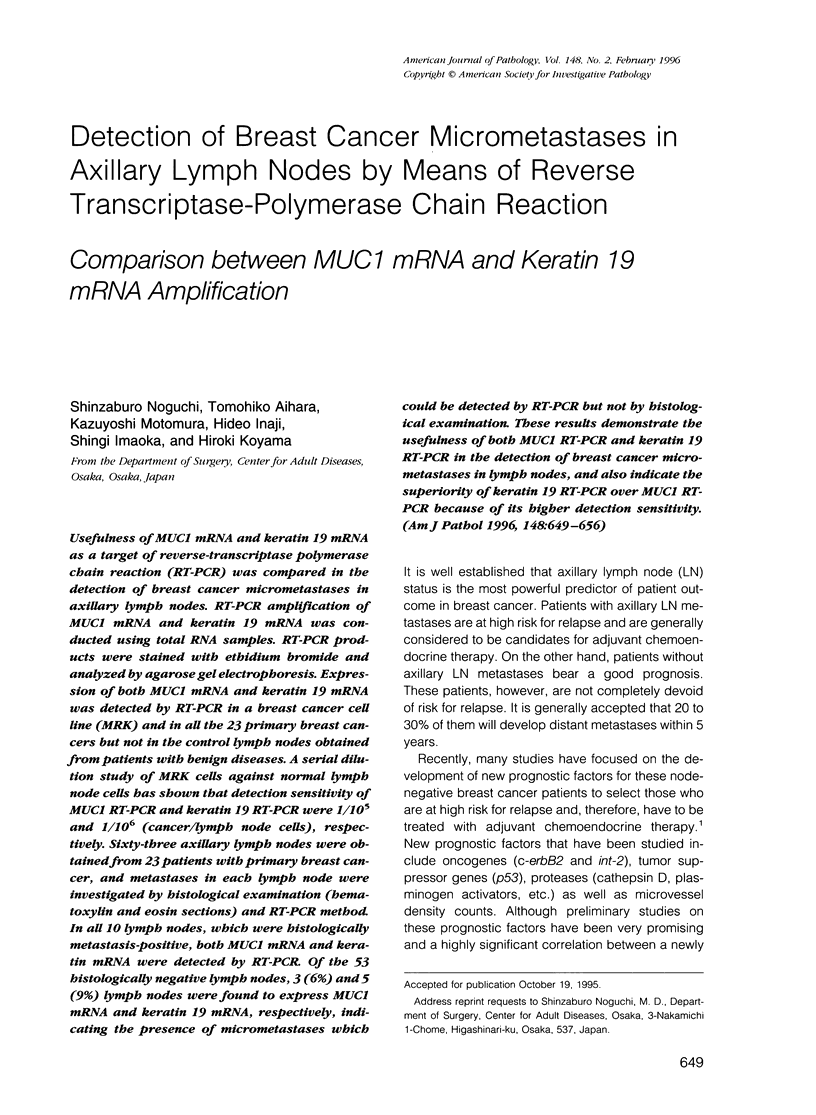
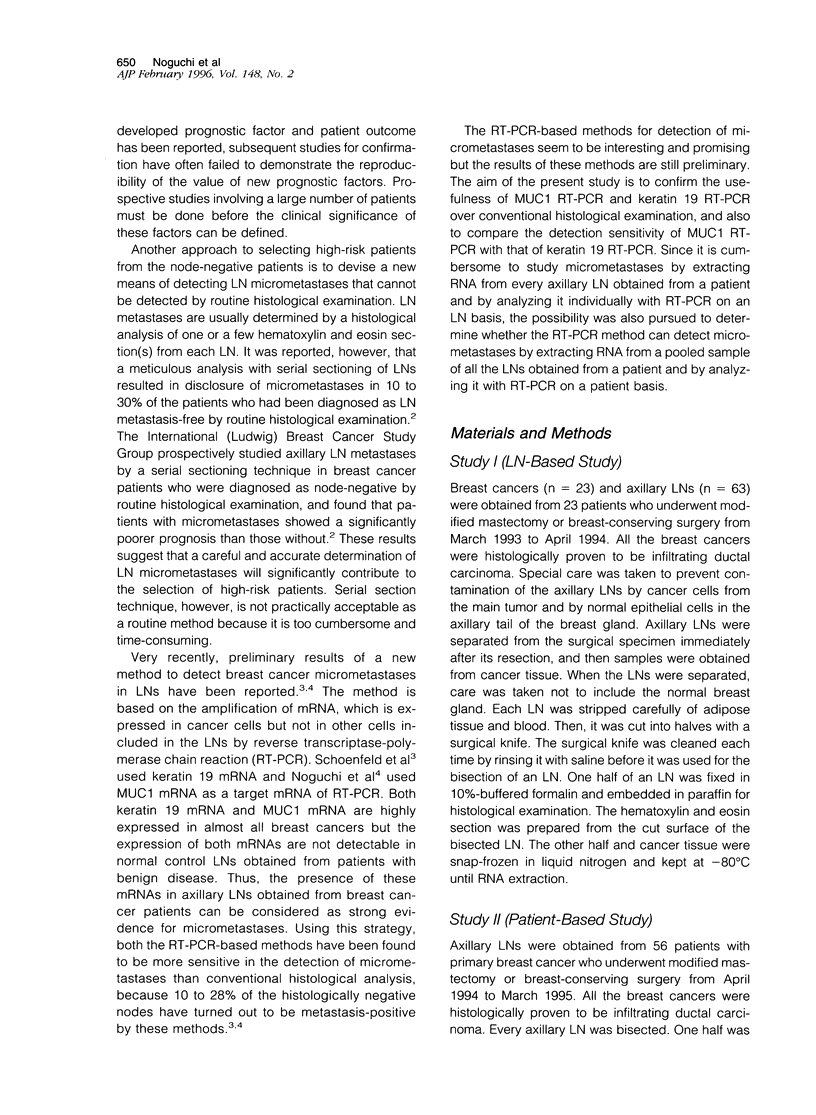
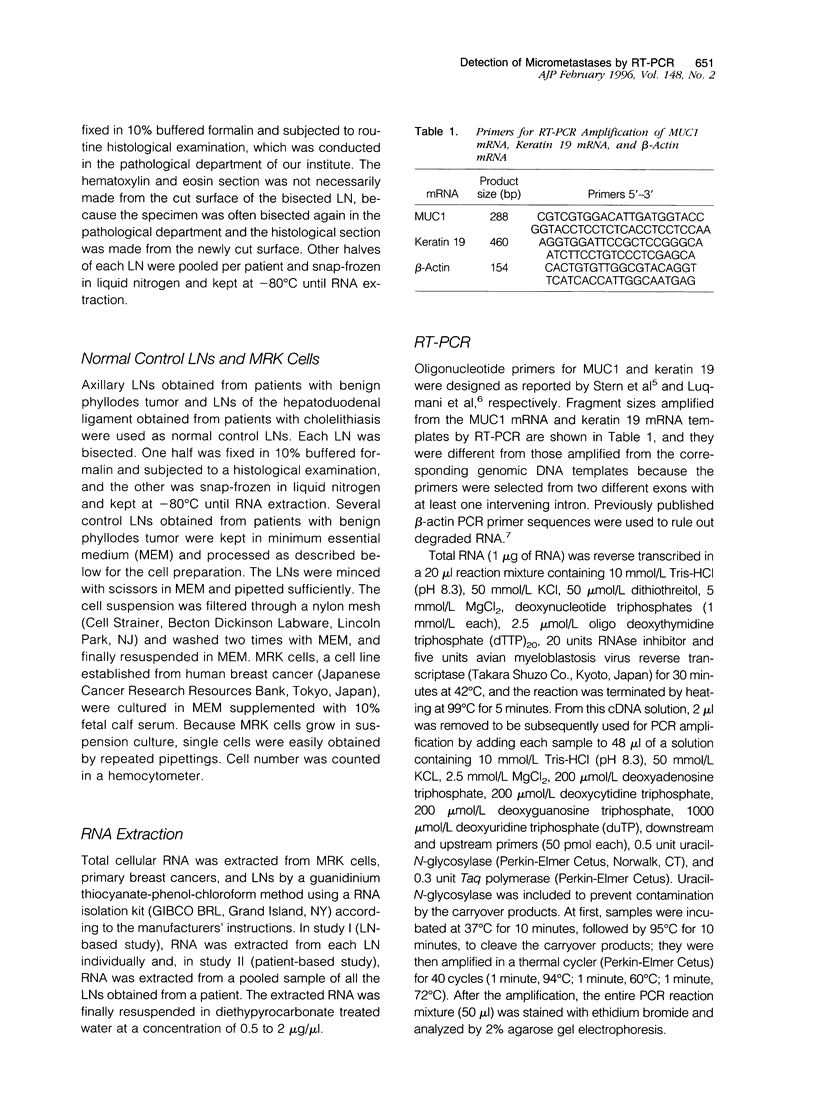
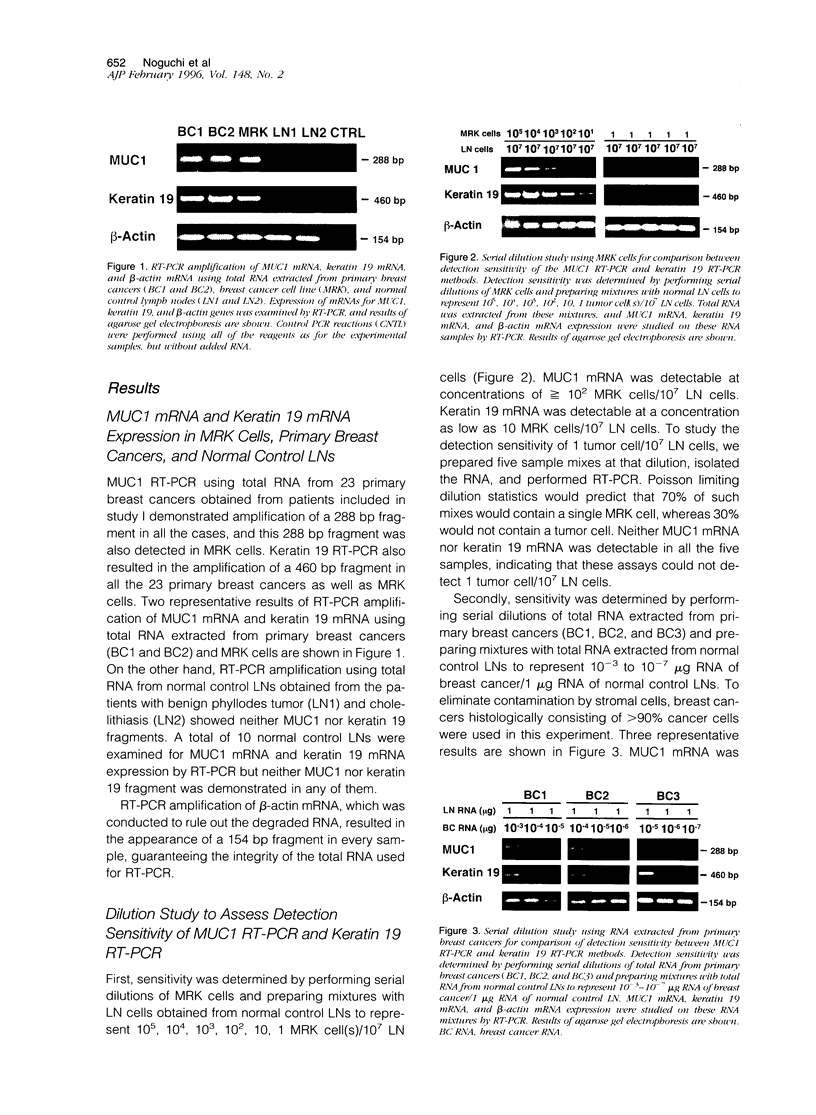

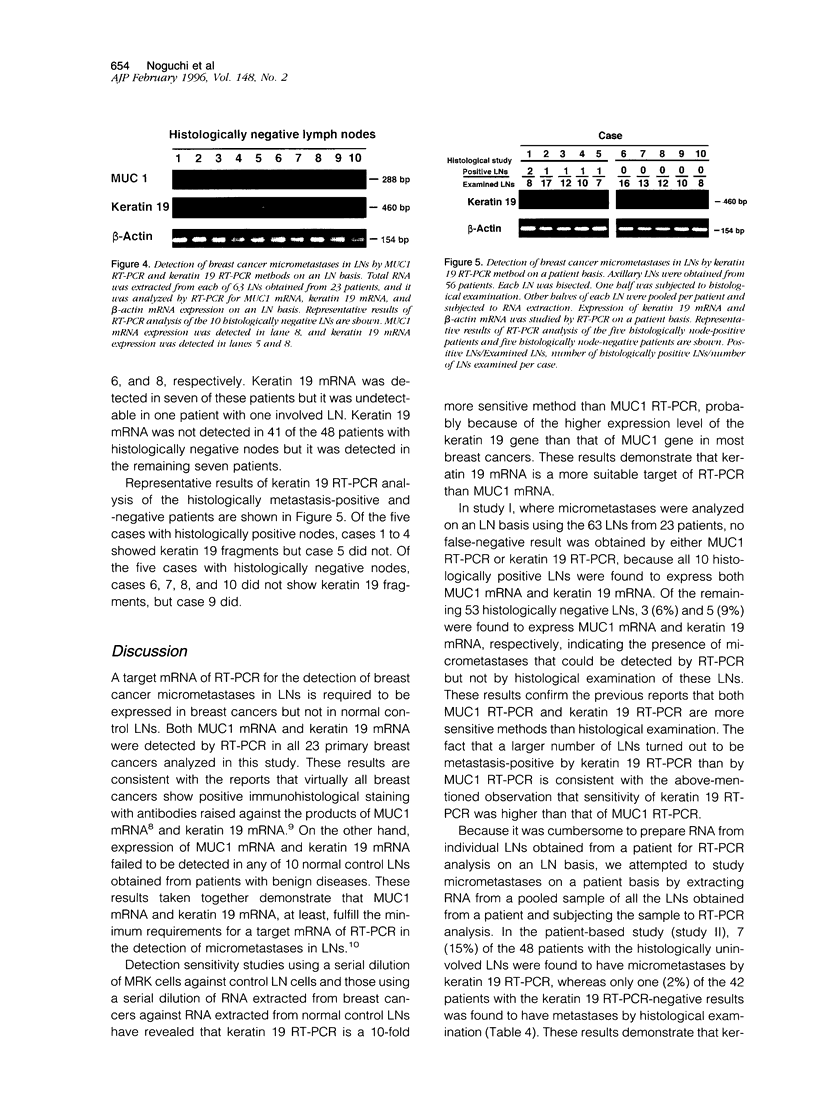

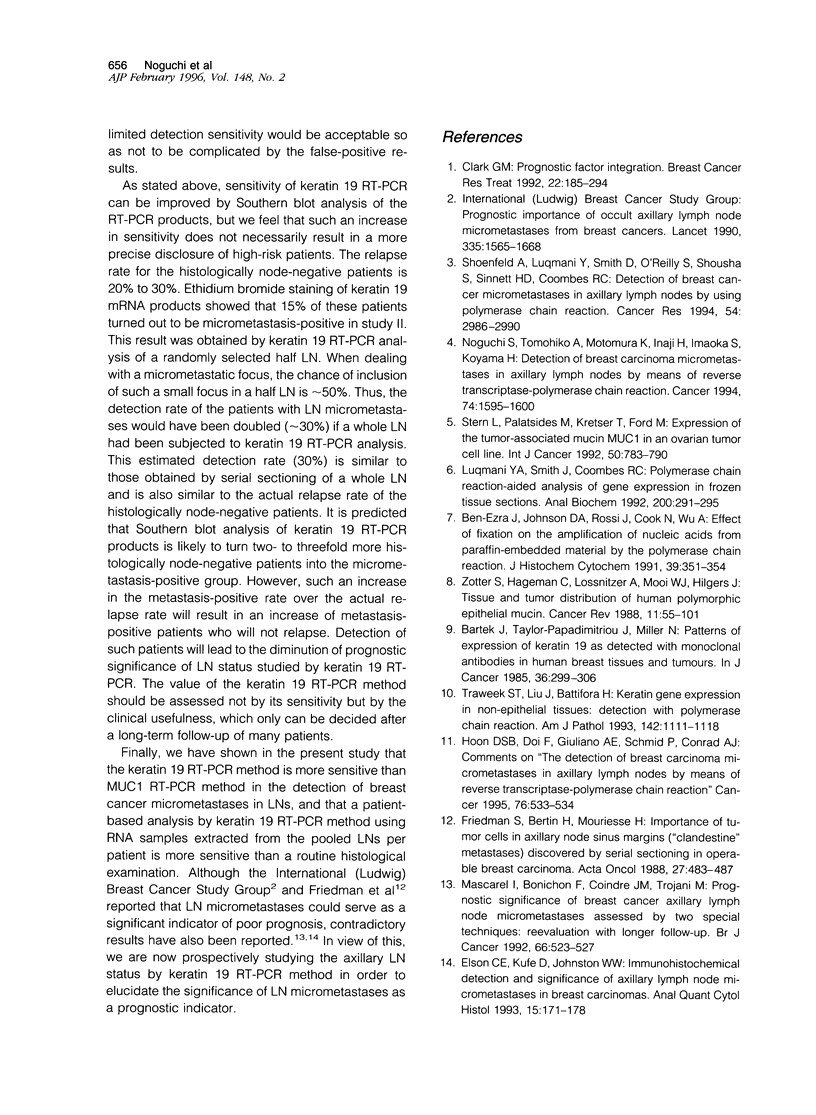
Images in this article
Selected References
These references are in PubMed. This may not be the complete list of references from this article.
- Bartek J., Taylor-Papadimitriou J., Miller N., Millis R. Patterns of expression of keratin 19 as detected with monoclonal antibodies in human breast tissues and tumours. Int J Cancer. 1985 Sep 15;36(3):299–306. [PubMed] [Google Scholar]
- Ben-Ezra J., Johnson D. A., Rossi J., Cook N., Wu A. Effect of fixation on the amplification of nucleic acids from paraffin-embedded material by the polymerase chain reaction. J Histochem Cytochem. 1991 Mar;39(3):351–354. doi: 10.1177/39.3.1704393. [DOI] [PubMed] [Google Scholar]
- Elson C. E., Kufe D., Johnston W. W. Immunohistochemical detection and significance of axillary lymph node micrometastases in breast carcinoma. A study of 97 cases. Anal Quant Cytol Histol. 1993 Jun;15(3):171–178. [PubMed] [Google Scholar]
- Friedman S., Bertin F., Mouriesse H., Benchabat A., Genin J., Sarrazin D., Contesso G. Importance of tumor cells in axillary node sinus margins ('clandestine' metastases) discovered by serial sectioning in operable breast carcinoma. Acta Oncol. 1988;27(5):483–487. doi: 10.3109/02841868809093575. [DOI] [PubMed] [Google Scholar]
- Hoon D. S., Doi F., Giuliano A. E., Schmid P., Conrad A. J. The detection of breast carcinoma micrometastases in axillary lymph nodes by means of reverse transcriptase-polymerase chain reaction. Cancer. 1995 Aug 1;76(3):533–535. doi: 10.1002/1097-0142(19950801)76:3<533::aid-cncr2820760330>3.0.co;2-t. [DOI] [PubMed] [Google Scholar]
- Luqmani Y. A., Smith J., Coombes R. C. Polymerase chain reaction-aided analysis of gene expression in frozen tissue sections. Anal Biochem. 1992 Feb 1;200(2):291–295. doi: 10.1016/0003-2697(92)90468-m. [DOI] [PubMed] [Google Scholar]
- Noguchi S., Aihara T., Nakamori S., Motomura K., Inaji H., Imaoka S., Koyama H. The detection of breast carcinoma micrometastases in axillary lymph nodes by means of reverse transcriptase-polymerase chain reaction. Cancer. 1994 Sep 1;74(5):1595–1600. doi: 10.1002/1097-0142(19940901)74:5<1595::aid-cncr2820740516>3.0.co;2-l. [DOI] [PubMed] [Google Scholar]
- Schoenfeld A., Luqmani Y., Smith D., O'Reilly S., Shousha S., Sinnett H. D., Coombes R. C. Detection of breast cancer micrometastases in axillary lymph nodes by using polymerase chain reaction. Cancer Res. 1994 Jun 1;54(11):2986–2990. [PubMed] [Google Scholar]
- Stern L., Palatsides M., de Kretser T., Ford M. Expression of the tumor-associated mucin MUC1 in an ovarian tumor cell line. Int J Cancer. 1992 Mar 12;50(5):783–790. doi: 10.1002/ijc.2910500520. [DOI] [PubMed] [Google Scholar]
- Traweek S. T., Liu J., Battifora H. Keratin gene expression in non-epithelial tissues. Detection with polymerase chain reaction. Am J Pathol. 1993 Apr;142(4):1111–1118. [PMC free article] [PubMed] [Google Scholar]
- de Mascarel I., Bonichon F., Coindre J. M., Trojani M. Prognostic significance of breast cancer axillary lymph node micrometastases assessed by two special techniques: reevaluation with longer follow-up. Br J Cancer. 1992 Sep;66(3):523–527. doi: 10.1038/bjc.1992.306. [DOI] [PMC free article] [PubMed] [Google Scholar]







